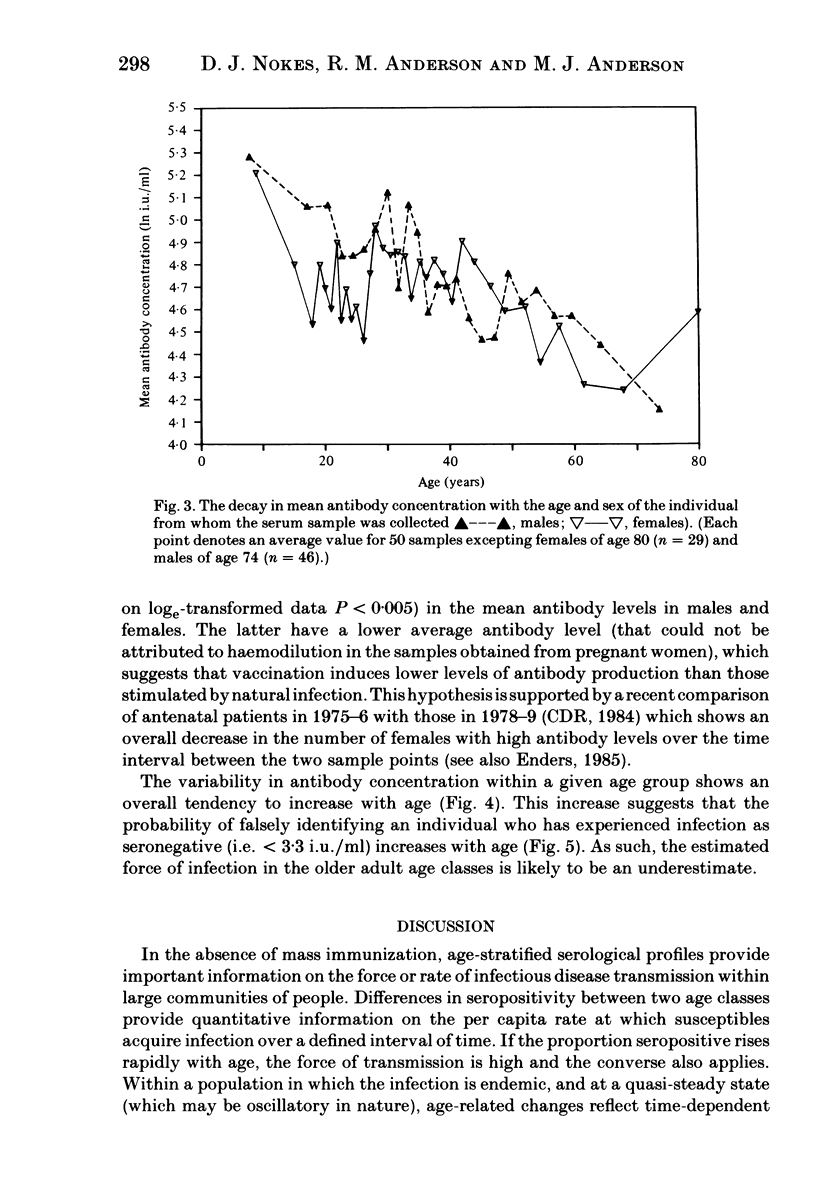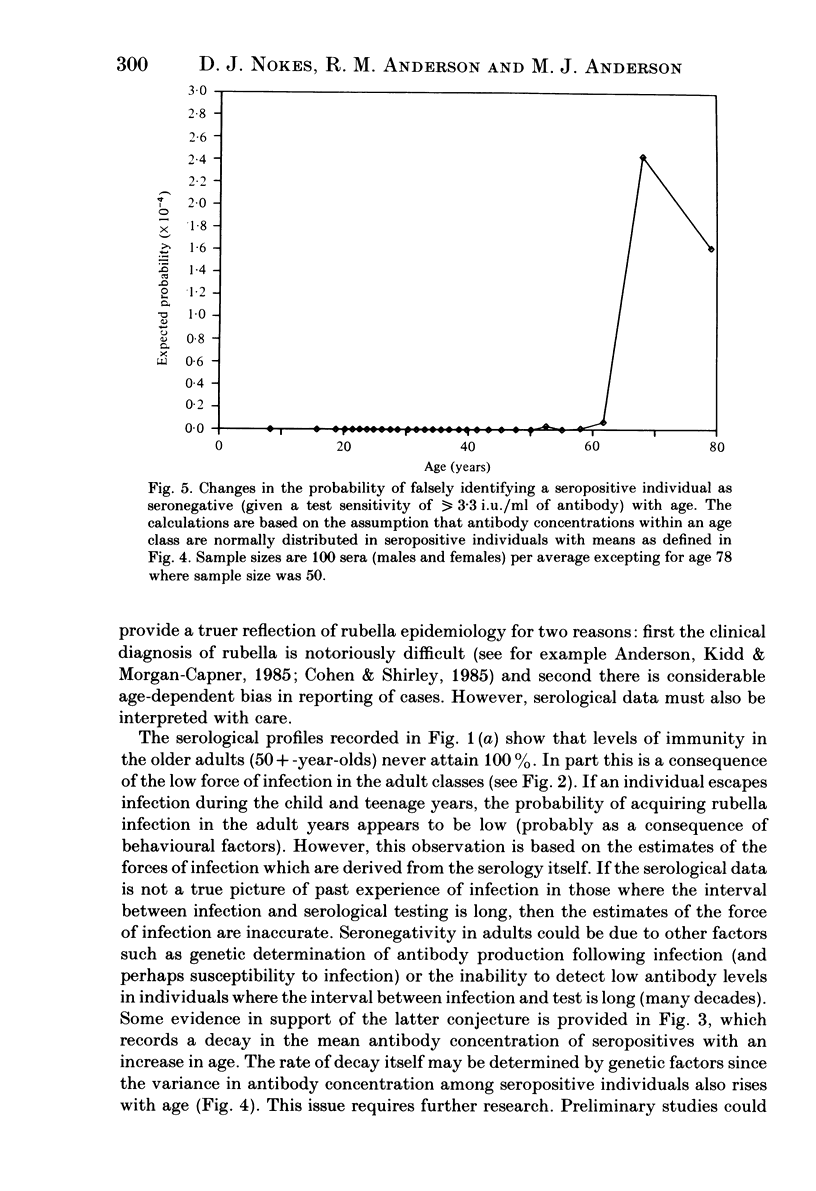Abstract
Analyses of data collected in a large survey (sample size greater than 3000) of rubella antibody in South East England, finely stratified according to age, reveal age-dependent changes in the pattern of virus transmission. The rate or force of infection changes from low in the young children to high in the 5- to 15-year-olds and back to low again in the adult age classes (there is a 50% reduction between the 5- to 15-year-olds and the 20+-year-olds). Raised levels of immunity are recorded in the teenage and young adult female segments of the population as a consequence of the UK rubella immunization programme. Mean antibody concentrations show a decline with age and are, on average, lower in vaccinated females when compared with unvaccinated males of the same age. The interpretation of horizontal cross-sectional serological data and future research needs are discussed.
Full text
PDF













Selected References
These references are in PubMed. This may not be the complete list of references from this article.
- Anderson M. J., Kidd I. M., Morgan-Capner P. Human parvovirus and rubella-like illness. Lancet. 1985 Sep 21;2(8456):663–663. doi: 10.1016/s0140-6736(85)90025-x. [DOI] [PubMed] [Google Scholar]
- Anderson R. M., Grenfell B. T., May R. M. Oscillatory fluctuations in the incidence of infectious disease and the impact of vaccination: time series analysis. J Hyg (Lond) 1984 Dec;93(3):587–608. doi: 10.1017/s0022172400065177. [DOI] [PMC free article] [PubMed] [Google Scholar]
- Anderson R. M., Grenfell B. T. Quantitative investigations of different vaccination policies for the control of congenital rubella syndrome (CRS) in the United Kingdom. J Hyg (Lond) 1986 Apr;96(2):305–333. doi: 10.1017/s0022172400066079. [DOI] [PMC free article] [PubMed] [Google Scholar]
- Anderson R. M., May R. M. Age-related changes in the rate of disease transmission: implications for the design of vaccination programmes. J Hyg (Lond) 1985 Jun;94(3):365–436. doi: 10.1017/s002217240006160x. [DOI] [PMC free article] [PubMed] [Google Scholar]
- Anderson R. M., May R. M. Directly transmitted infections diseases: control by vaccination. Science. 1982 Feb 26;215(4536):1053–1060. doi: 10.1126/science.7063839. [DOI] [PubMed] [Google Scholar]
- Anderson R. M., May R. M. Spatial, temporal, and genetic heterogeneity in host populations and the design of immunization programmes. IMA J Math Appl Med Biol. 1984;1(3):233–266. doi: 10.1093/imammb/1.3.233. [DOI] [PubMed] [Google Scholar]
- Anderson R. M., May R. M. Two-stage vaccination programme against rubella. Lancet. 1983 Dec 17;2(8364):1416–1417. doi: 10.1016/s0140-6736(83)90939-x. [DOI] [PubMed] [Google Scholar]
- Anderson R. M., May R. M. Vaccination against rubella and measles: quantitative investigations of different policies. J Hyg (Lond) 1983 Apr;90(2):259–325. doi: 10.1017/s002217240002893x. [DOI] [PMC free article] [PubMed] [Google Scholar]
- Anderson Roy, May Robert. The logic of vaccination. New Sci. 1982 Nov 18;96(1332):410–415. [PubMed] [Google Scholar]
- BLACK F. L. Measles antibodies in the population of New Haven, Connecticut. J Immunol. 1959 Jul;83(1):74–82. [PubMed] [Google Scholar]
- Balfour H. H., Jr, Groth K. E., Edelman C. K., Amren D. P., Best J. M., Banatvala J. E. Rubella viraemia and antibody responses after rubella vaccination and reimmunization. Lancet. 1981 May 16;1(8229):1078–1080. doi: 10.1016/s0140-6736(81)92243-1. [DOI] [PubMed] [Google Scholar]
- Clarke M., Schild G. C., Boustred J., McGregor I. A., Williams K. Epidemiological studies of rubella virus in a tropical African community. Bull World Health Organ. 1980;58(6):931–935. [PMC free article] [PubMed] [Google Scholar]
- Clarke M., Seagroatt V., Schild G. C., Pollock T. M., Miller C., Finlay S. E., Barbara J. A. Surveys of rubella antibodies in young adults and children. Lancet. 1983 Mar 26;1(8326 Pt 1):667–669. doi: 10.1016/s0140-6736(83)91966-9. [DOI] [PubMed] [Google Scholar]
- Cohen B. J., Shirley J. A. Dual infection with rubella and human parvovirus. Lancet. 1985 Sep 21;2(8456):662–663. doi: 10.1016/s0140-6736(85)90024-8. [DOI] [PubMed] [Google Scholar]
- Field A. M. The occurrence of neutralizing and complement fixing antibodies in rubella. J Hyg (Lond) 1967 Sep;65(3):409–421. doi: 10.1017/s0022172400045927. [DOI] [PMC free article] [PubMed] [Google Scholar]
- Fine P. E., Clarkson J. A. Measles in England and Wales--I: An analysis of factors underlying seasonal patterns. Int J Epidemiol. 1982 Mar;11(1):5–14. doi: 10.1093/ije/11.1.5. [DOI] [PubMed] [Google Scholar]
- Grenfell B. T., Anderson R. M. The estimation of age-related rates of infection from case notifications and serological data. J Hyg (Lond) 1985 Oct;95(2):419–436. doi: 10.1017/s0022172400062859. [DOI] [PMC free article] [PubMed] [Google Scholar]
- Harcourt G. C., Best J. M., Banatvala J. E. Rubella-specific serum and nasopharyngeal antibodies in volunteers with naturally acquired and vaccine-induced immunity after intranasal challenge. J Infect Dis. 1980 Aug;142(2):145–155. doi: 10.1093/infdis/142.2.145. [DOI] [PubMed] [Google Scholar]
- Hethcote H. W. Measles and rubella in the United States. Am J Epidemiol. 1983 Jan;117(1):2–13. doi: 10.1093/oxfordjournals.aje.a113511. [DOI] [PubMed] [Google Scholar]
- Kantorovich R. A., Gol'dfarb L. G., Volodina N. I., Myskin A. A. Analysis of epidemiological peculiarities of rubella based on a mathematical model (according to observations over 10 years in Moscow). J Hyg Epidemiol Microbiol Immunol. 1983;27(1):43–50. [PubMed] [Google Scholar]
- Kato S., Muranaka S., Takakura I., Kimura M., Tsuji K. HLA-DR antigens and the rubella-specific immune response in man. Tissue Antigens. 1982 Feb;19(2):140–145. doi: 10.1111/j.1399-0039.1982.tb01430.x. [DOI] [PubMed] [Google Scholar]
- Knox E. G. Strategy for rubella vaccination. Int J Epidemiol. 1980 Mar;9(1):13–23. doi: 10.1093/ije/9.1.13. [DOI] [PubMed] [Google Scholar]
- Kurtz J. B., Mortimer P. P., Mortimer P. R., Morgan-Capner P., Shafi M. S., White G. B. Rubella antibody measured by radial haemolysis. Characteristics and performance of a simple screening method for use in diagnostic laboratories. J Hyg (Lond) 1980 Apr;84(2):213–222. doi: 10.1017/s0022172400026711. [DOI] [PMC free article] [PubMed] [Google Scholar]
- Mortimer P. P., Edwards J. M., Porter A. D., Tedder R. S., Mace J. E., Hutchinson A. Are many women immunized against rubella unnecessarily? J Hyg (Lond) 1981 Aug;87(1):131–138. doi: 10.1017/s0022172400069308. [DOI] [PMC free article] [PubMed] [Google Scholar]
- Neumann P. W., Weber J. M. Single radial hemolysis test for rubella immunity and recent infection. J Clin Microbiol. 1983 Jan;17(1):28–34. doi: 10.1128/jcm.17.1.28-34.1983. [DOI] [PMC free article] [PubMed] [Google Scholar]
- O'Shea S., Best J. M., Banatvala J. E., Marshall W. C., Dudgeon J. A. Persistence of rubella antibody 8-18 years after vaccination. Br Med J (Clin Res Ed) 1984 Apr 7;288(6423):1043–1043. doi: 10.1136/bmj.288.6423.1043. [DOI] [PMC free article] [PubMed] [Google Scholar]
- O'Shea S., Best J. M., Banatvala J. E., Marshall W. C., Dudgeon J. A. Rubella vaccination: persistence of antibodies for up to 16 years. Br Med J (Clin Res Ed) 1982 Jul 24;285(6337):253–255. doi: 10.1136/bmj.285.6337.253. [DOI] [PMC free article] [PubMed] [Google Scholar]
- O'Shea S., Best J. M., Banatvala J. E., Shepherd W. M. Development and persistence of class-specific antibodies in the serum and nasopharyngeal washings of rubella vaccinees. J Infect Dis. 1985 Jan;151(1):89–98. doi: 10.1093/infdis/151.1.89. [DOI] [PubMed] [Google Scholar]
- O'Shea S., Best J. M., Banatvala J. E. Viremia, virus excretion, and antibody responses after challenge in volunteers with low levels of antibody to rubella virus. J Infect Dis. 1983 Oct;148(4):639–647. doi: 10.1093/infdis/148.4.639. [DOI] [PubMed] [Google Scholar]
- Schenzle D. An age-structured model of pre- and post-vaccination measles transmission. IMA J Math Appl Med Biol. 1984;1(2):169–191. doi: 10.1093/imammb/1.2.169. [DOI] [PubMed] [Google Scholar]
- Wagenvoort J. H., Harmsen M., Boutahar-Trouw B. J., Kraaijeveld C. A., Winkler K. C. Epidemiology of mumps in the Netherlands. J Hyg (Lond) 1980 Dec;85(3):313–326. doi: 10.1017/s0022172400063385. [DOI] [PMC free article] [PubMed] [Google Scholar]
- Yorke J. A., London W. P. Recurrent outbreaks of measles, chickenpox and mumps. II. Systematic differences in contact rates and stochastic effects. Am J Epidemiol. 1973 Dec;98(6):469–482. doi: 10.1093/oxfordjournals.aje.a121576. [DOI] [PubMed] [Google Scholar]


